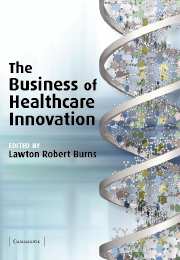Book contents
- Frontmatter
- Contents
- List of figures
- List of contributors
- Preface
- Acknowledgments
- 1 The business of healthcare innovation in the Wharton School curriculum
- Part I The life sciences
- 2 The pharmaceutical sector
- 3 The biotechnology sector – therapeutics
- 4 Biotechnology business and revenue models: the dynamic of technological evolution and capital market ingenuity
- 5 Mergers, acquisitions, and the advantages of scale in the pharmaceutical sector
- Part II Devices and information technologies
- Index
3 - The biotechnology sector – therapeutics
Published online by Cambridge University Press: 22 September 2009
- Frontmatter
- Contents
- List of figures
- List of contributors
- Preface
- Acknowledgments
- 1 The business of healthcare innovation in the Wharton School curriculum
- Part I The life sciences
- 2 The pharmaceutical sector
- 3 The biotechnology sector – therapeutics
- 4 Biotechnology business and revenue models: the dynamic of technological evolution and capital market ingenuity
- 5 Mergers, acquisitions, and the advantages of scale in the pharmaceutical sector
- Part II Devices and information technologies
- Index
Summary
Introduction
The biotechnology sector was born about thirty years ago when technology zealots, investors, and entrepreneurs alike set out to utilize novel scientific discoveries around genetic engineering and a landmark court decision to create a business that would improve healthcare and agriculture in ways that before could only have been imagined. At the time, biotechnology, strictly speaking, was the use of genetic engineering techniques to create unique cells that could produce proteins that under normal circumstances would not be produced. The hope was that using this technology to modify the genetic material of a living cell, pest-resistant plant cells, and human cell factories producing large quantities of proteins with therapeutic potential could be created. As one looks back over the last thirty years, without a doubt these entrepreneurs were right, although the sector has endured many hurdles along the way. Focusing primarily on the therapeutic segment, this chapter will review the impact the biotechnology sector has had on parts of the healthcare sector, including pharmaceutical companies and patient care, the forces that continue to drive the sector, its growth globally, and the regulatory environment in which it must operate.
In analyzing the biotechnology sector, the perspective of time is important. Since the product development cycle of biotechnology drug development is about fifteen years from discovery through commercialization, the sector is still in its infancy, and even the sector's earliest entrants have barely passed through two cycles.
- Type
- Chapter
- Information
- The Business of Healthcare Innovation , pp. 103 - 189Publisher: Cambridge University PressPrint publication year: 2005
- 3
- Cited by

